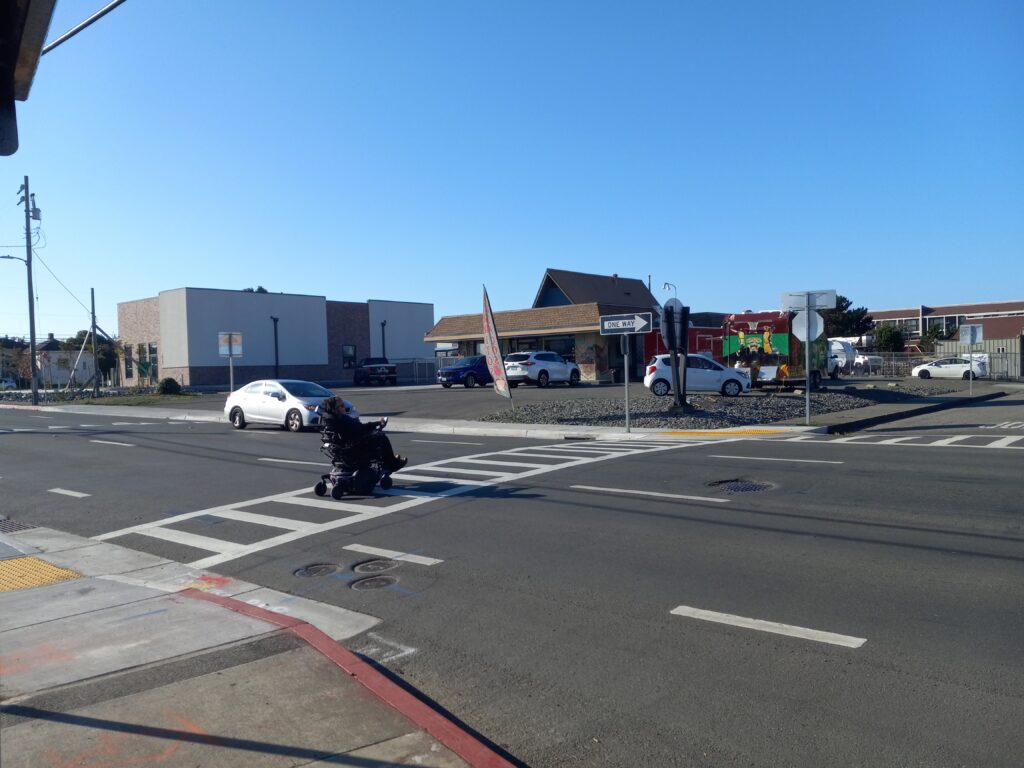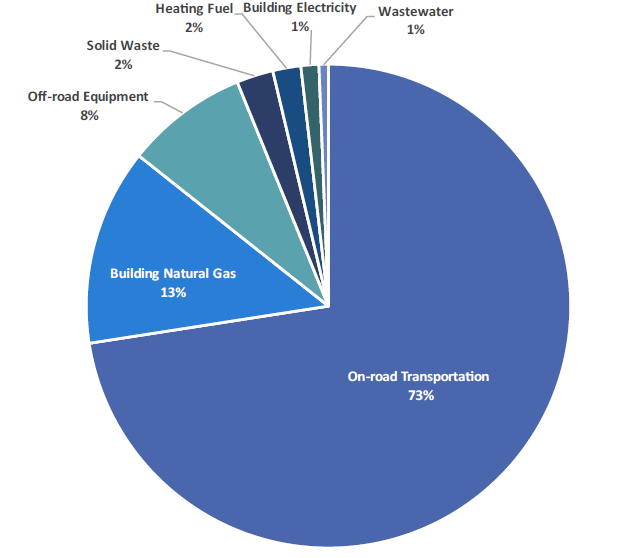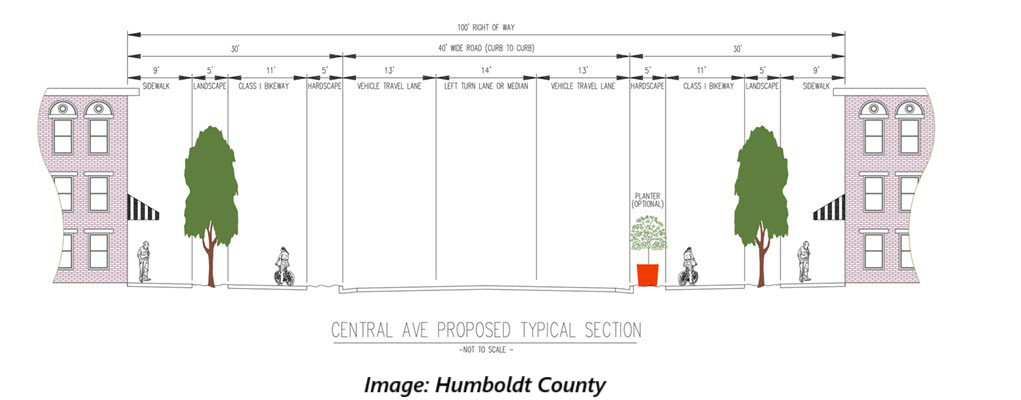The Collector
October 10, 2025
Dangerous Downtown Streets
This week, CRTP published a new report entitled “Dangerous Downtown Streets: Safety Problems and Solutions for Eureka’s 4th & 5th Street Corridor (US-101).” The report identifies safety hazards for pedestrians, bicyclists, bus riders, and motorists by reviewing official police-reported crash data, Street Story reports, and the findings from our recent walk and bike audits in the corridor.
Despite representing only about 0.2% of the county’s road miles, the corridor has been the site of 18% of the county’s pedestrian fatalities and serious injuries in the last decade, meaning the rate of pedestrian fatalities and serious injuries per mile is 90 times the county average. The corridor also sees 4% of all bicyclist serious injuries (20 times the county average) and 3% of motorist serious injuries and fatalities (15 times the county average). The walk and bike audits and Street Story reports confirm that, along with Broadway, this is one of the most dangerous corridors in the region, especially for people walking and biking.
In conjunction with the release of the report, CRTP has also produced point-of-view videos using wearable cameras, documenting the experiences of pedestrians and bicyclists in the 4th & 5th Street corridor. These include videos from perspectives that are often underrepresented, including a child and people with disabilities.
The South Broadway Complete Streets Project currently under construction is a good start toward making the US-101 corridor in Eureka safer for everyone. At CRTP, we continue to advocate for Caltrans to fund and build the other two planned safety projects that will improve the rest of Broadway right away. But this other part of the corridor—4th and 5th Streets—is also very dangerous, and can’t be ignored.
Click here to read the full report. If you’d like to report a safety concern in the corridor to Caltrans, click here and scroll down to “Safety Concern” in the “Situation Type” menu. We also encourage everyone to continue making Street Story reports, so that concerns are publicly documented.
First Hearing Next Week for Regional Climate Action Plan
Humboldt County officially began work on its Regional Climate Action Plan way back in 2018. After numerous delays, mistakes, and false starts, the plan is finally scheduled for its first formal adoption hearing before the county’s Planning Commission next Thursday.
Almost three-quarters of the climate pollution covered by the plan comes from transportation. That means that upgrading our local infrastructure and services, and changing our land use rules, to make low-carbon options like walking, biking, rolling, and riding the bus safer, easier, and more appealing are keys to the plan’s success.
At CRTP, we have been advocating all along to make sure the plan is robust and ambitious enough to meet the urgent need, and there are still changes we think should be made to improve it. But we are also relieved to see it finally moving toward adoption and implementation, and looking forward to having an official regional committee and dedicated local government staff devoted solely to climate action.
McKinleyville Town Center Ordinance Heads to Supervisors
The new zoning rules for the future McKinleyville Town Center have been scheduled for a final hearing before the Humboldt County Board of Supervisors on Monday, October 20th at 9 am. While the hearing is still more than a week away, written comments must be sent to the county by next Wednesday to be officially included in the agenda packet.
Opponents are still trying to block key elements of the ordinance, especially the Central Avenue lane reduction that is so important for community safety and for the Town Center’s success. But this ordinance is the result of six years of public meetings and community engagement, and shouldn’t be changed at the last minute because of a few loud voices. We’ll be working hard to ensure the Central Avenue safety overhaul and other key provisions remain in the ordinance when it’s adopted.
What Did Local Leaders Learn from the Week Without Driving?
The Week Without Driving is over, but many of the lessons learned will stick with participants for a long time. 66 people officially participated in Humboldt County, including elected officials, public agency staff, and other community leaders. Click here to read some of the reflections they shared from their experiences.
People Are Using the Humboldt Bay Trail!
The first numbers are in from trail counters along the newly opened Humboldt Bay Trail, and it’s official: a lot people are using it! County data show hundreds of bicyclists and dozens of pedestrians using the trail every day, and Arcata trail counts show that bicyclist usage more than tripled between May and July on the city’s part of the trail. It all goes to show: when you give them half a chance, people really want to bike, walk, and roll more!
News from Beyond the North Coast
Republican Funding Bill “Not So Clean” for Transportation
Since before the federal government shutdown began, Congressional Republicans have been calling their funding bill “clean,” meaning it continues existing funding levels without making any policy changes. But transportation advocates point out that official funding and policies don’t mean much as the Trump administration continues to eliminate safety, bike, pedestrian, and transit programs it doesn’t like, and ignores funding already appropriated by Congress for these purposes.
Caltrans Can Now Lower Speed Limits More Easily
The traditional method for setting speed limits in the United States relies on measuring existing driving speeds, and rewards speeders by increasing the limit when people drive faster. Thankfully, several new California laws in recent years have made it somewhat easier to lower speed limits in certain situations. Until now, though, these laws have applied only on local streets and roads. A bill authored by the North Coast’s own Assemblymember Chris Rogers and just signed by Governor Newsom will extend this flexibility to state highways, allowing Caltrans to lower some speed limits, especially on surface streets like Broadway, 4th and 5th Streets in Eureka.
Federal Government Delays Pedestrian Safety Rules for Vehicles
The official “five-star” safety rating system in the United States has only ever considered the safety of vehicle occupants – never the safety of pedestrians, bicyclists, or even the occupants of other vehicles a driver might hit. A change to that system initiated under the Biden administration would finally incorporate some pedestrian safety testing into the rating system. But the auto industry complained and asked for a delay, and the Trump administration has now given it to them.
Self-Driving? Really?
Should a car company be able to say its vehicles are “self-driving” when they still require a human driver for safety? And when they can’t recognize and respond safely to a bicyclist? We don’t think so, and neither does CalBike.
The Collector is CRTP’s weekly transportation news roundup, published every Friday. We focus on North Coast news, but we also include relevant state, national and international transportation news – plus other items that we just find kind of interesting! To submit items for consideration, email colin@transportationpriorities.org.



